FOIA Release: Joint Chiefs issue worldwide UAP reporting requirements (May 19, 2023)

By Douglas Dean Johnson
@ddeanjohnson on X/Twitter /// gmail address is my full name
Publication date: March 26, 2024. Any substantive post-publication changes will be noted in a log placed at the end of the article. I published a shorter version of this article on my X/Twitter account, @ddeanjohnson, on March 18, 2024, which was the day that I received the FOIA release.
On May 19, 2023, the Joint Staff (J3, Operations; J36 Homeland Defense Division) of the Joint Chiefs of Staff disseminated to all unified military commands worldwide a set of uniform procedures to be followed for gathering data and reporting on contemporary military encounters with Unidentified Anomalous Phenomena (UAP), using a detailed standard reporting template.
The document was not made public until March 18, 2024, when I received a copy in response to a Freedom of Information Act (FOIA) request that I had submitted in August 2023. Within hours, I published the complete release on my X/Twitter account, @ddeanjohnson, and several other platforms. There was apparently substantial interest in the document– my X post alone elicited about 320,000 "impressions" and over 15,000 "engagements" during the first week, and there were many spin-off discussions of the document.
The Joint Staff message was designated as "GENADMIN Joint Staff J3 Washington DC 191452ZMAY23 Unidentified Anomalous Phenomena Reporting and Material Disposition." The entire nine-page document, along with the Final Response letter that I received from the Department of Defense Freedom of Information Act Division (dated March 15, 2024, but transmitted on March 18, 2024), and my original FOIA request (all with minimal redactions to protect privacy), are embedded as a single PDF document below (those reading the email version of this article will have to invoke a browser to access it). The same PDF document should be downloadable from this link. In addition, I have posted the nine pages of the May 19, 2023 GENADMIN message as .jpg images at the bottom of this article.
In an article dated August 30, 2023 ("Hicks takes direct oversight of Pentagon’s UAP office; new reporting website to be launched"), journalist Brandi Vincent (@BrandiVincent_) of DefenseScoop referred in passing to the existence of this Joint Staff message (as quoted below). After seeing that reference, I promptly asked Pentagon press officer Susan Gough to release a copy to me, but Gough replied, "I cannot provide a copy of the message to you, as it contains information that’s not publicly releasable." On August 31, 2023, I filed a FOIA request for the GENADMIN message. On March 18, 2024, I received the entire 9-page document from the Department of Defense Freedom of Information Division, with only minimal privacy-related redactions, along with a Final Response cover letter. As already noted, within hours I made the entire release publicly available.
The GENADMIN message was disseminated as "CUI," which means "Controlled Unclassified Information," and this is presumably why Ms. Gough did not release it to me in response to my initial request. An agency that creates a document classified as CUI does not initially intend it for dissemination to the general public. However, it is generally understood throughout the government (or should be) that documents classified as CUI are subject to mandatory release in response to a FOIA request, except for any portions that are covered by the explicit exemptions contained in FOIA itself. In this case it appears that none of the statutory FOIA exemptions were deemed applicable to the substance of the document.
INITIAL OBSERVATIONS
Among the noteworthy aspects of the May 2023 Joint Staff guidance:
● An introductory paragraph states: "The U.S. government has observed UAP in or near the territory and/or operating areas of the United States, of its allies, and of its adversaries, and observing, identifying, and potentially mitigating UAP has become a growing priority for US policymakers, lawmakers, and warfighters. The potentially ubiquitous presence of UAP defines the national security implications of those anomalies, which range from operational hazards and threats to technological and intelligence surprise to adversaries' strategic miscalculations. It is imperative that DoD provide UAP incident, incursion, and engagement... reporting, data, and material for the Department's detection and mitigation of potential threats; exploitation of advanced technologies; and informing policymaker and warfighter decisions."
● Reports on UAP incidents are to be transmitted upwards within 96 hours, but any "UAP engagement reports" within 12 hours. A "UAP engagement is a kinetic or non-kinetic response to a UAP, intended to deny, disrupt, or destroy the phenomenon and/or its object(s)."
● The ultimate nexus of collection and analysis of these reports is the All-domain Anomaly Resolution Office (AARO).
● The reporting procedures in the Joint Staff message apply only to detections or encounters "that demonstrate behaviors not readily understood by sensors or observers...[that] include but are not limited to phenomena that demonstrate apparent capabilities or material that exceed known performance envelopes." The UAP reporting procedures described in this directive do NOT apply to "incidents, incursions, and engagements by identifiable, non-anomalous phenomena (e.g., sUAS and other capabilities or materials that do not exceed known or predicted performance envelopes);" such incidents will instead "continue to be reported through established processes and mechanisms."
● The reporting matrix seeks 11 categories of information– among these, any UAP-displayed "anomalous characteristics/behaviors (e.g., no apparent control surfaces, extreme acceleration/direction change, detection by certain sensors but not others)," and any "UAP effects on equipment (e.g., mechanical, electrical controls and weapons systems and whether persistent or transitory").
● AARO will coordinate the handling of any UAP "objects and material of incidents, intrusions, and engagements," but "recovery and transfer of identifiable, non-anomalous items of foreign origin...continue to be managed by the DoD FMP [Foreign Material Program]." Thus, this guidance makes a distinction between the manner in which two different types of recovered materials are to be handled, depending on their nature or the nature of the incident that produced them.
● The military commands are to "enable deployment of special sensors within the AoR [area of responsibility] for the detection, observation, and identification in sensitive areas, and during testing or deployment of special capabilities."
REACTIONS TO MY PUBLICATION OF THE DOCUMENT
In response to my March 18, 2024 publication of the Joint Staff GENADMIN document, some commentators suggested that the document revealed an internal division within the government with regard to UAP– i.e., that UAP incidents were a matter of substantial concern to the top military leadership, and that this contradicted the stance being disseminated by leaders of AARO. Some commentators contrasted the Joint Staff message with AARO's dismissive conclusions regarding some UAP-related claims in its Report on the Historical Record of U.S. Government Involvement with Unidentified Anomalous Phenomena (UAP) Volume 1 (henceforth, "the Historical Report"), the unclassified version of which was released on March 8, 2024.
For example, journalist-commentator Ross Coulthart tweeted on March 18, 2024 that the FOIA-released document showed that "in defiance of @DoD_AARO's disinterest – the @DeptofDefense Joint Chiefs are taking #UAPs now very seriously indeed."
It may be fair to perceive tensions, at least with respect to emphasis, between some passages of the GENADMIN message and some recent public utterances by AARO's former director, Dr. Sean Kirkpatrick, who has also been identified as the prime author of the Historical Report Volume 1. However, it also should be noted that in the August 30, 2023 article by Brandi Vincent that first reported the existence of the May 2023 Joint Staff message, "Hicks takes direct oversight of Pentagon's UAP office; new reporting website to be launched," the Joint Staff guidance was itself presented as one of the products of AARO's recent work. Vincent wrote:
DefenseScoop viewed a timeline in an unofficial memo that allegedly records all the major steps AARO previously pursued aligned with the website development up until July 31 [2023]– the same date that [Deputy Secretary of Defense Kathleen] Hicks convened stakeholders to discuss AARO's website and formally directed DOD to provide that office with any administrative and technical support needed to build and launch the online portal successfully....That month [May 2023], the Joint Staff also separately published a "GENADMIN" message on "Unidentified Anomalous Phenomena Reporting and Material Disposition" that offers guidance to the military services and commands about reporting UAP worldwide, using a standard reporting template. The template is a result of work AARO has pursued with military leaders to improve and standardize reporting procedures across the force, since its inception.
In a general sense, at least, I think the data-collection system advanced in the May 2023 GENADMIN is consistent with the public stance of Kirkpatrick, who retired as AARO director effective December 1, 2023, but remains an advisor to the office. For example, in an essay titled "We Need to Investigate UFOs. But Without the Distraction of Conspiracy Theories," published by Scientific American on March 6, 2024, Kirkpatrick wrote:
AARO’s interest--all-domain phenomena (sea, air and space)--remains an ongoing concern to our national security enterprise, particularly when the phenomena are observed near our nation’s sensitive military and critical infrastructure facilities. Observations by experienced military personnel as well as data from highly capable sensors are being reviewed by AARO, accordingly, to weed out explainable observations and expose truly difficult-to-explain phenomenology using the most rigorous scientific analysis available. This is its real job: to minimize the risk of intelligence and technical surprise.
I do not offer these observations as any manner of defense of the Historical Report; I think that the Historical Report had multiple substantial deficiencies, although it also contained some valuable new information regarding some specific UAP-related government programs, and regarding investigations of certain claims involving alleged possession of non-human technology or biological remains. Further discussion of the Historical Report is outside of the scope of this article– however, I personally see nothing in the Historical Report that denigrates the value of establishing systematic UAP data-gathering throughout the military and the rest of the government (which, in any event, is part of AARO's mission as dictated by the governing congressional enactments).
THE VARIOUS REPORTING SYSTEMS, CURRENT AND CONTEMPLATED
On its website, AARO uses the term "Current Operational UAP Reporting" to describe the military reporting system as spelled out in the May 2023 GENADMIN message. In a briefing for selected journalists on March 6, 2024, AARO Acting Director Tim Phillips said that AARO is receiving "approximately...anywhere between 90 and a 100-110 a month" through such channels.
A transcript of the March 6, 2024 media briefing, as posted by the Department of Defense, is embedded below (if you're reading the email version, you'll need to invoke a browser), or may be accessed at this link.
Phillips also told the journalists, "We're trying to work out the command and control, the mechanisms on how other government entities can report UAP incidents to us. We've received a number of reports from Department of Homeland Security and their aircraft reporting to us that we follow up on."
As for civilian pilots, the AARO website states, "AARO receives UAP-related Pilot Reports (PIREPs) from the Federal Aviation Administration." Legislation has been proposed in Congress that would formalize a system for FAA collection of UAP reports from civil aviation sources. [1]
The UAP reporting system for contemporary military-associated UAP events, as set forth in the May 2023 Joint Staff message, is separate and distinct from the AARO "secure reporting" system for receiving reports "from current or former U.S. Government employees, service members, or contractor personnel with direct knowledge of U.S. Government programs or activities related to UAP dating back to 1945," which is accessible through a portal on the AARO website.
By statutory law, AARO may receive UAP-related information that is covered by any level of classification. [2] [3] [4] [5] In addition, the 2022 law incorporates explicit protections for individuals who choose to avail themselves of the authorized-disclosure system in order to report information pertaining to actual or perceived government-related UAP programs or incidents. [6] [7]
AARO has not yet deployed any system for receiving UAP observation reports from the general public.
Images of the nine pages of the May 19, 2023 Joint Staff GENADMIN appear below, followed by "End Notes" that provide more in-depth information on certain pertinent issues.
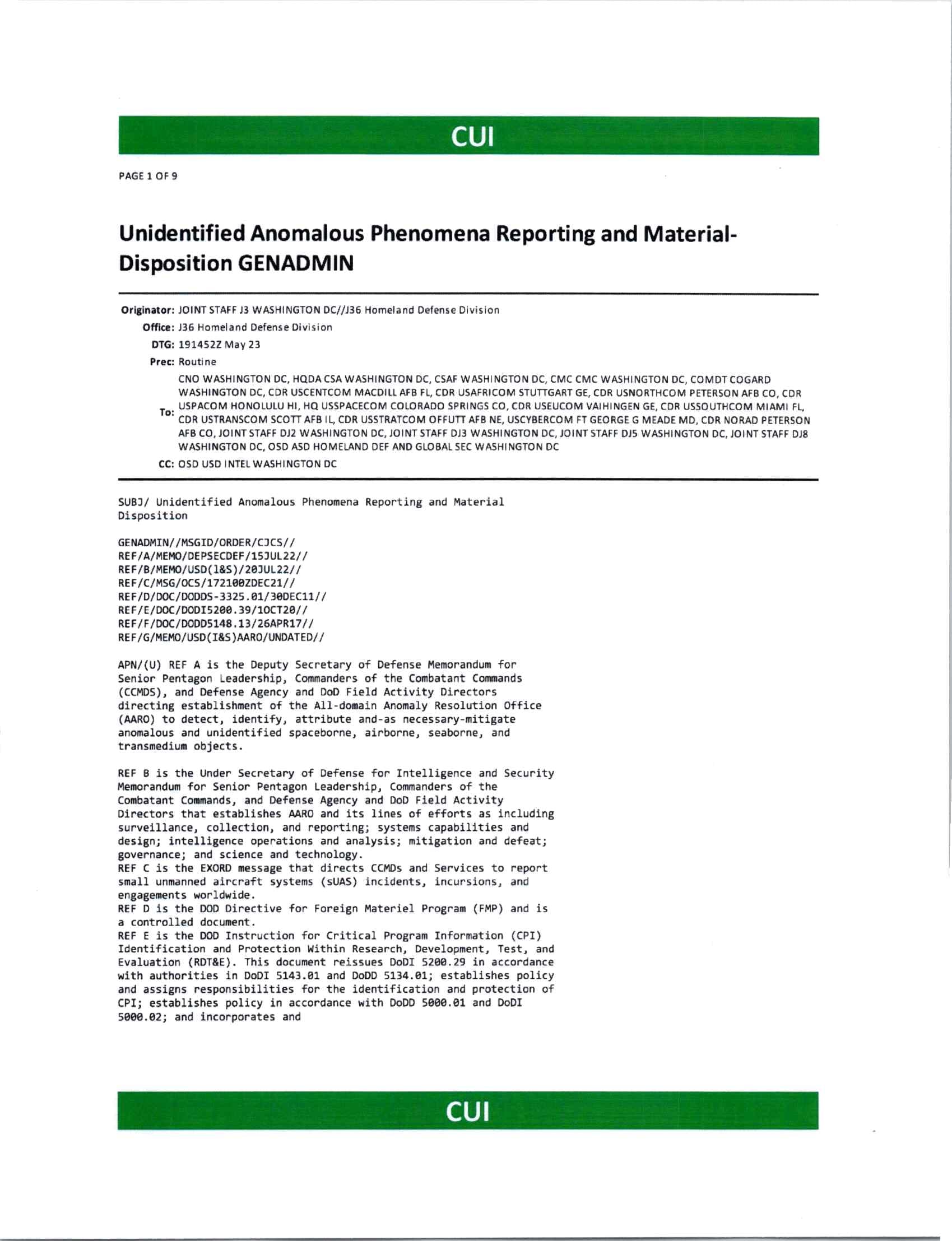

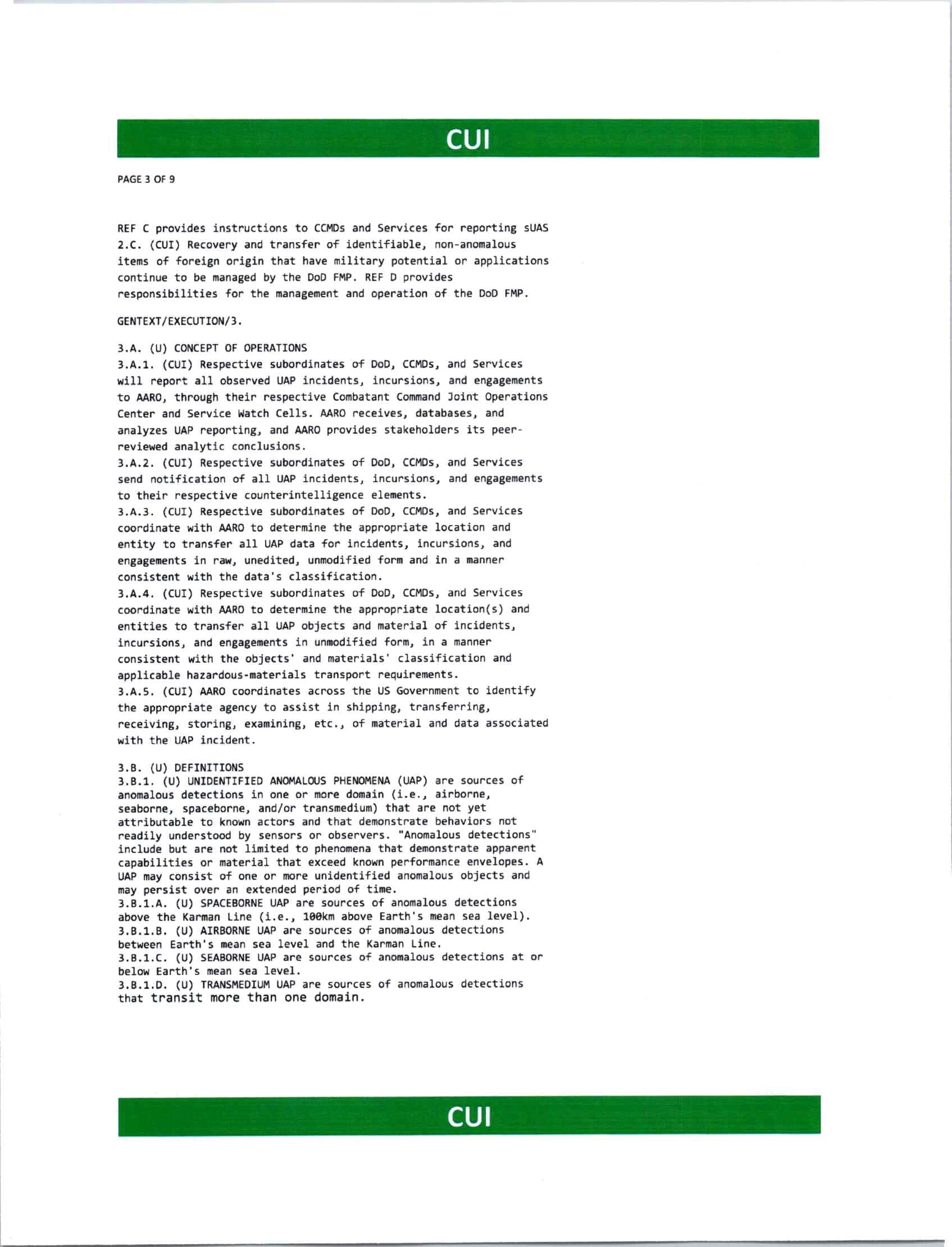

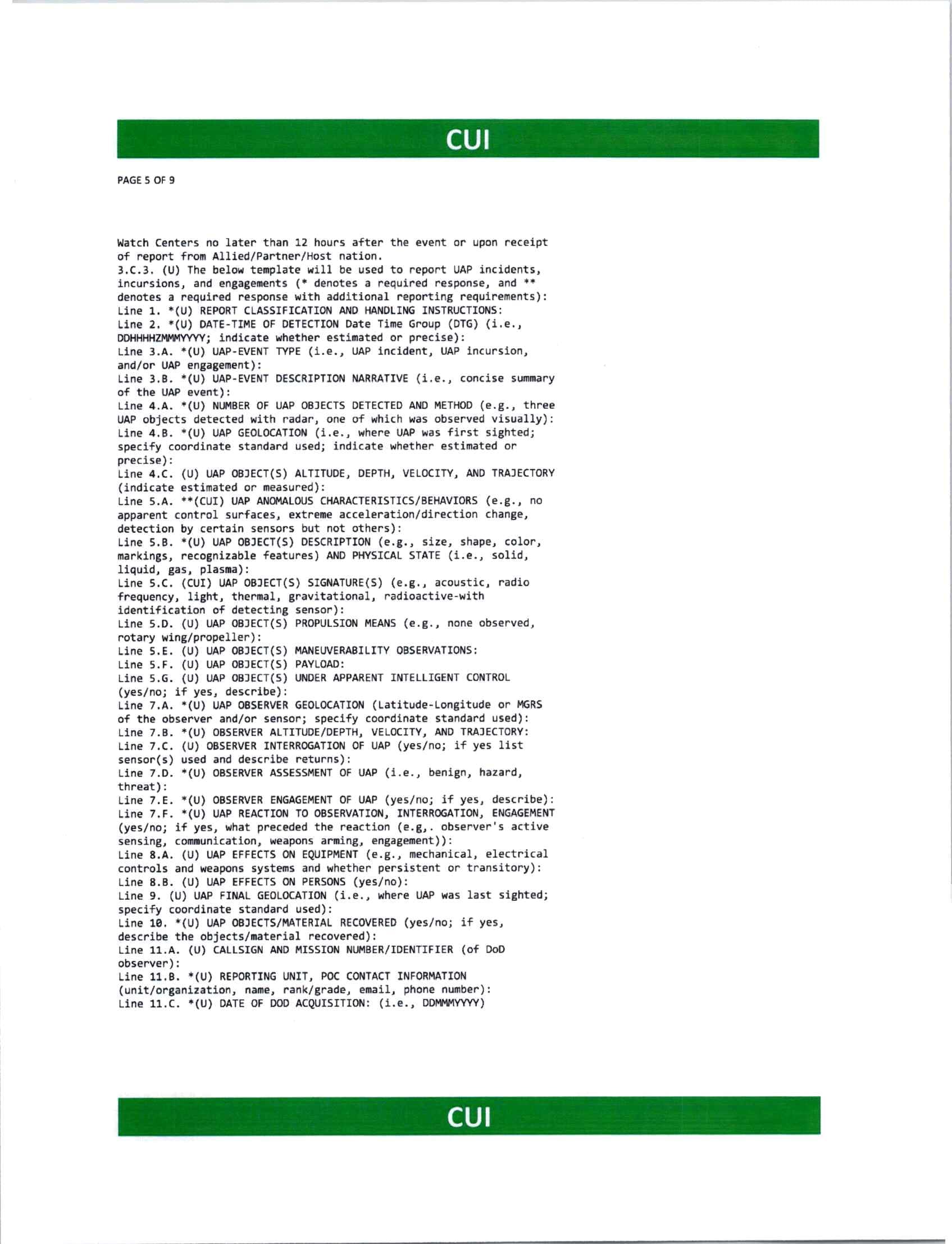
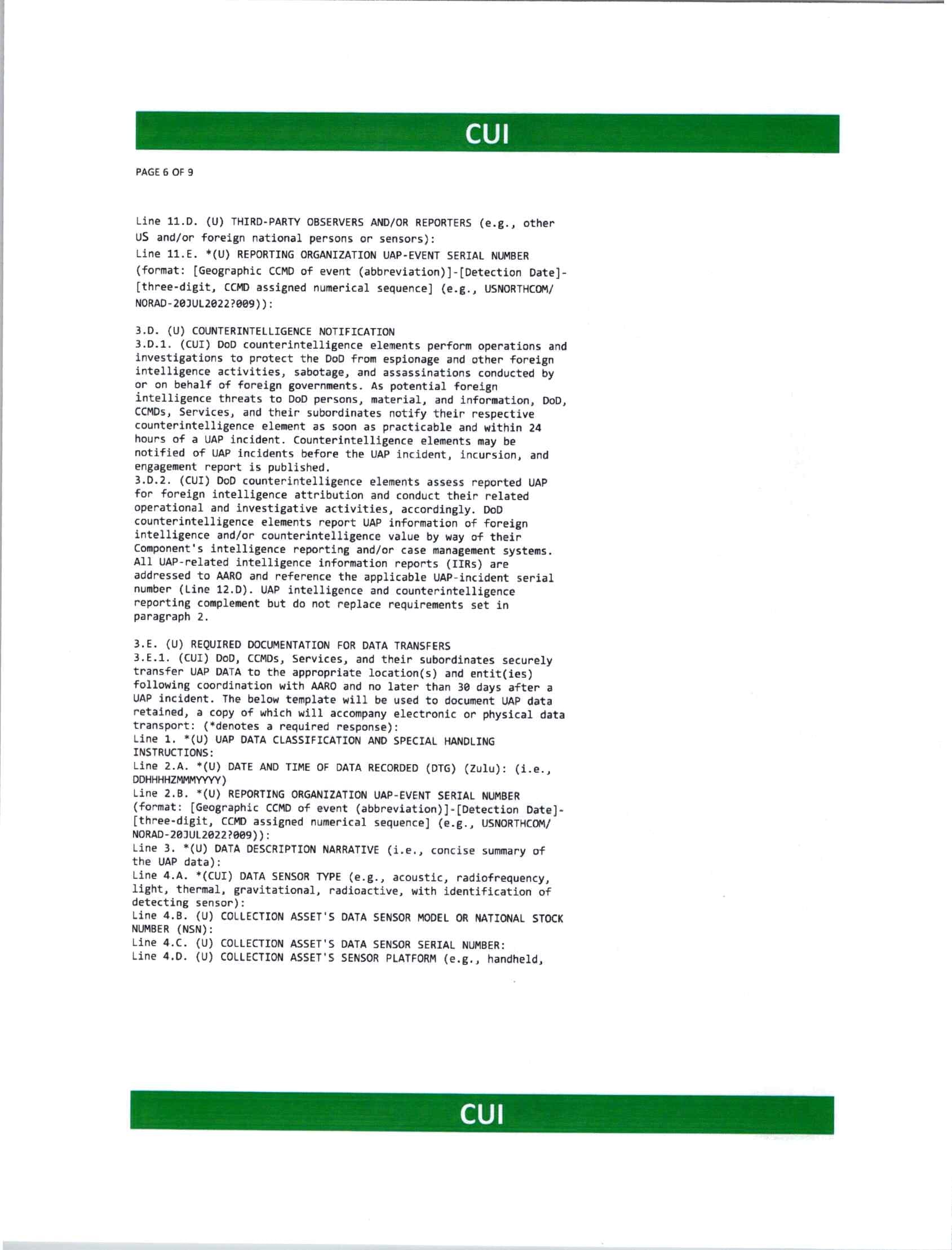
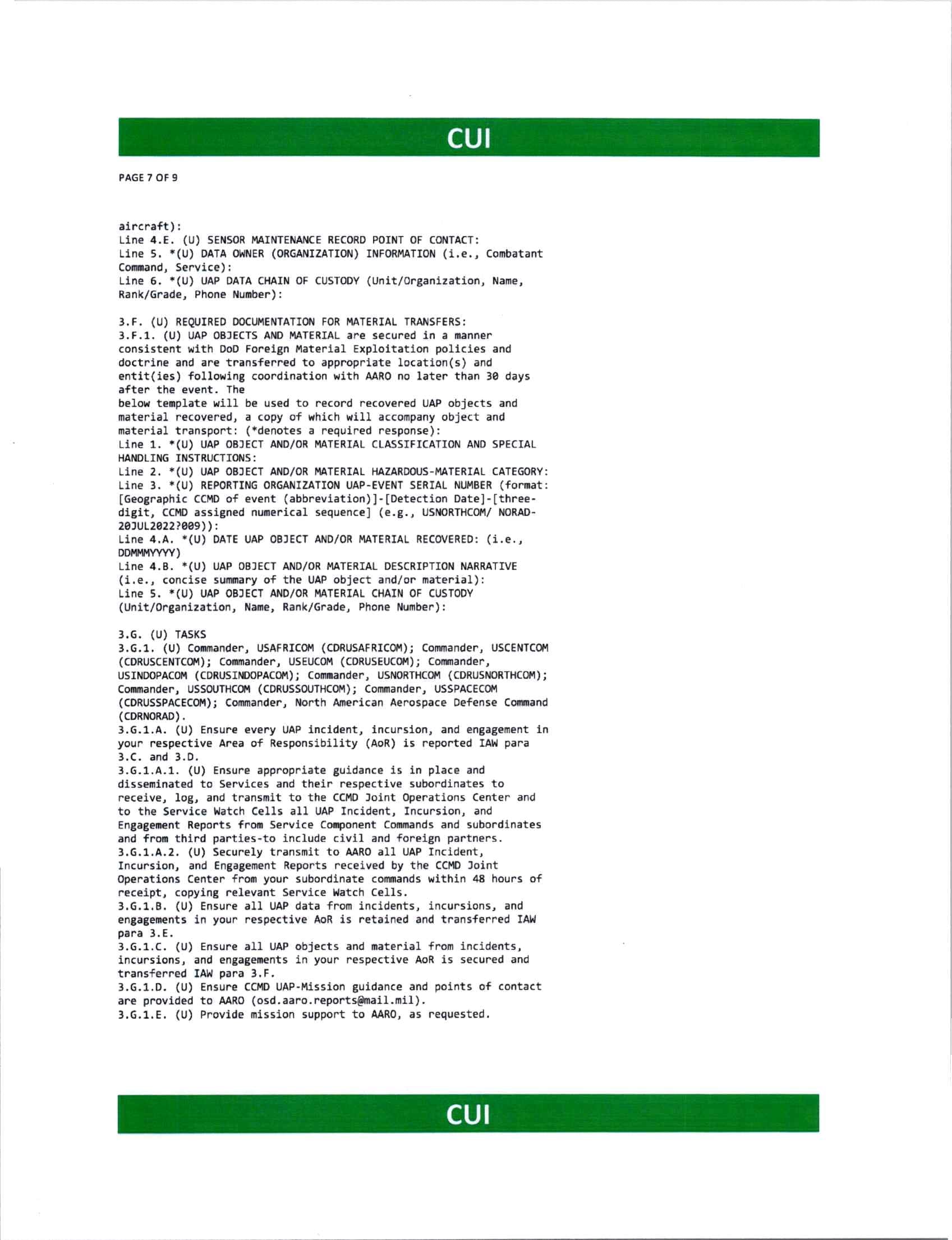
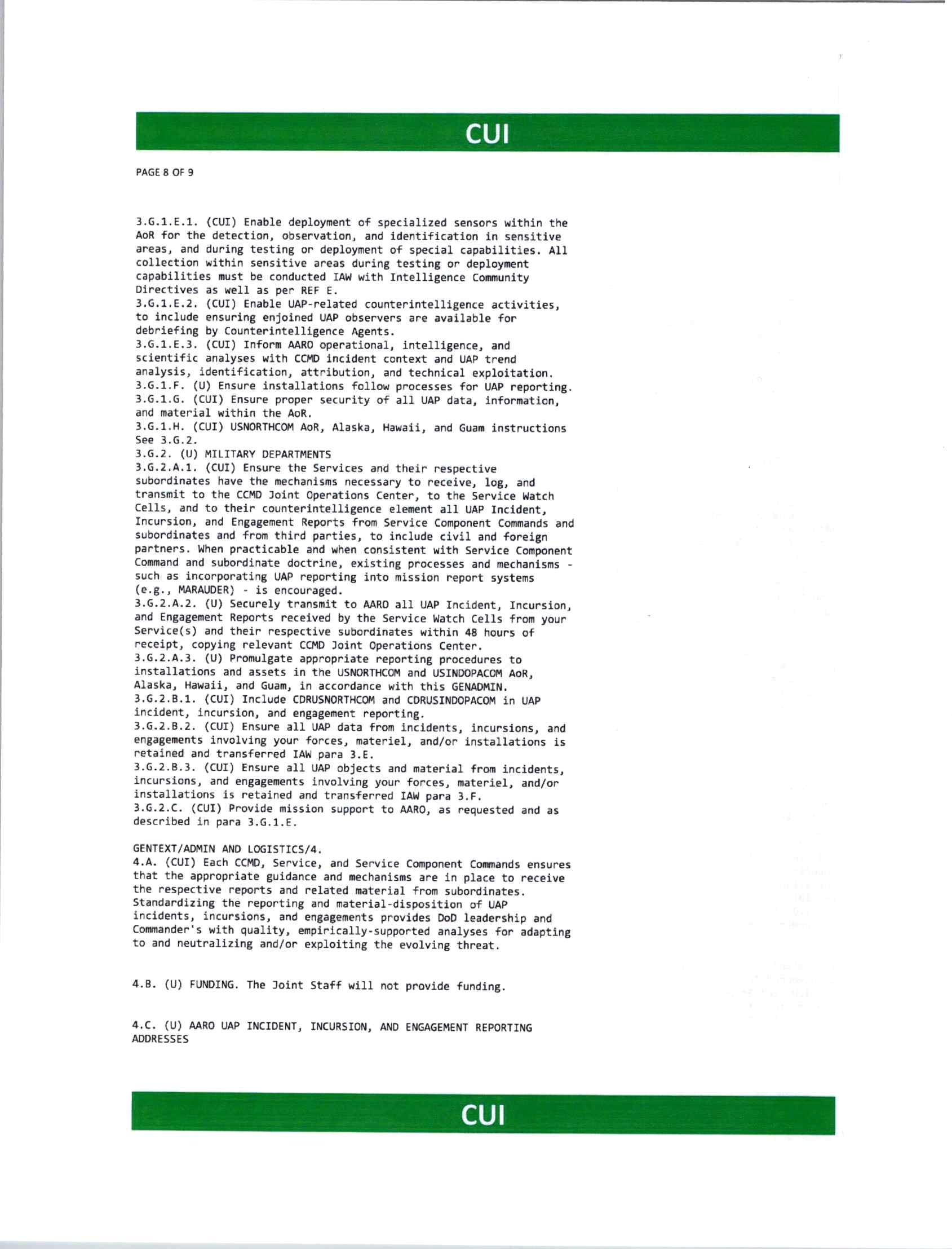
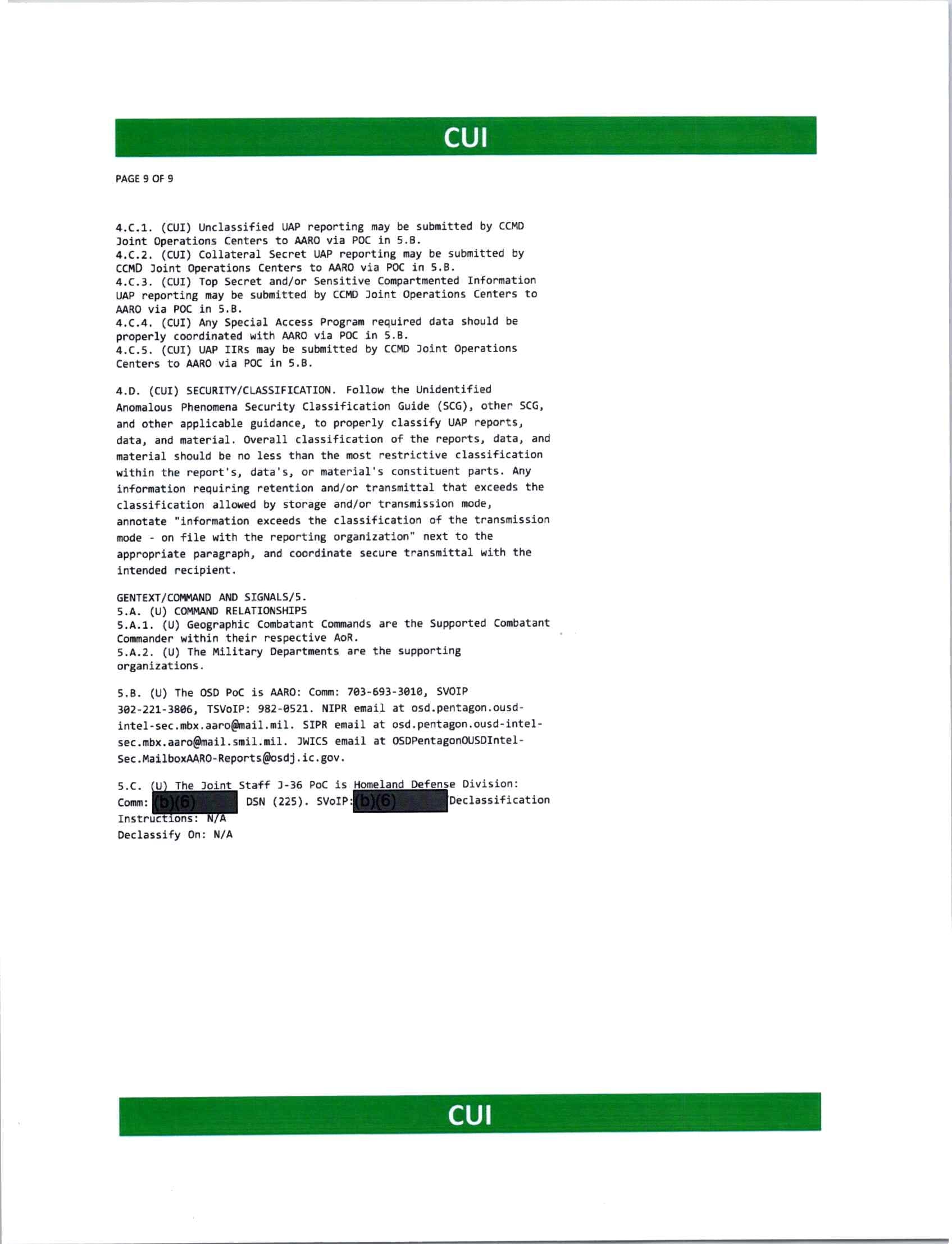
END NOTES
[1] The legislation is the Safe Airspace for Americans Act (H.R. 6967), introduced by Reps. Robert Garcia (D-CA) and Glenn Grothman (R-W). It has been referred to the House Transportation & Infrastructure Committee and to its Aviation Subcommittee. It has also been referred to the House Oversight & Accountability Committee, on which Grothman and Garcia serve as chair and ranking minority member, respectively, of the National Security subcommittee, which held a UAP-related hearing on July 26, 2023. No comparable legislation has yet been introduced in the Senate. More about the legislation here.
[2] While some have asserted that AARO lacks access to those secrets governed by Title 50 of the U.S. Code, relating to intelligence agencies and programs, that is not an accurate description of the state of the law. The misperception that AARO does not have access to Title 50 controlled-access projects is based in part on some muddled testimony by Sean Kirkpatrick before a subcommittee of the Senate Armed Services Committee on April 19, 2023. But by that time Congress had already specifically amended Title 50 to ensure that the All-domain Anomaly Resolution Office (AARO) would have authorities within both Title 50 and Title 10 realms. Kirkpatrick has characterized the law correctly in more recent utterances. From the FY 2023 National Defense Authorization Act (Public Law 117-263), as enacted December 23, 2022:
Title 50 U.S.C. Section 3373: (f) Data; intelligence collection: (1) Availability of data and reporting on unidentified anomalous phenomena (A) Availability of data. The Director of National Intelligence, in coordination with the Secretary of Defense, shall ensure that each element of the intelligence community with data relating to unidentified anomalous phenomena makes such data available immediately to the Office [AARO].
That broad authority was reinforced in other parts of Public Law 117-263, including the provisions dealing specifically with the congressionally mandated historical study. So why the muddled April 2023 testimony? The explanation probably is found is the slowness with which the Pentagon implemented various enactments by Congress on this subject. At that same Senate hearing in April 2023, Kirkpatrick indicated that he was not yet reporting to the Deputy Secretary of Defense, which Congress had also mandated in the law enacted four months earlier; the necessary bureaucratic adjustments had not yet been made. Not long after the April 19, 2023 hearing, the Department of Defense went out of its way to put out the word that the Deputy Secretary, Kathleen Hicks, had taken charge of AARO. See again "Hicks takes direct oversight of Pentagon's UAP office," by Brandi Vincent, DefenseScoop, August 30, 2023.
[3] The AARO website currently states:
By law, AARO may receive all UAP-related information, including any classified national security information, regardless of any restrictive access controls, special access programs, or compartmented access programs. Moreover, there is no restriction to AARO receiving any past or present UAP-related information, regardless of the organizational affiliation of the original classification authority within DoD, the Intelligence Community, or any other U.S. Government department or agency. As a reminder, individuals cannot report classified national security information on this website.
[4] During a March 6, 2024 briefing for a small number of selected journalists, a reporter asked AARO Acting Director Tim Phillips: "There are people who sincerely believe that the government has alien bodies, alien crafts, you know, that they have communicated with — with extraterrestrials. What can you tell them to try to bring some sort of resolution to this?" Phillips responded, "I can tell them that AARO, as designed by Congress, had unprecedented access to classified programs. Nobody blocked where we could go or the questions we asked. Nobody in the government influenced the findings in the report. As a career Intel officer, I am just amazed at the access we had to some of our nation's most sensitive programs. Nobody said no." However, it appears that somebody initially did say "no," because later in the same briefing, Phillips said, "So I don't think there's ever been a government organization with the authorities and with the amount of funding that we receive from Congress. As the acting director, I work for the Deputy Director of Defense...trying to get information, we've actually had to solicit her personal assistance to open a door. I don't believe any previous government attempt to research UFOs, UAPs has ever had that type of top cover."
[5] I leave for another day the interesting hypothetical question about whether a President could effectively invoke his intrinsic constitutional authority to lawfully order a subordinate agency head to ignore the statutory requirements relating to AARO's access authorities, congressional notification requirements, and so forth. I have seen no substantiated evidence or testimony to support claims that any President has ever issued any directive to shield information about non-prosaic UFOs from congressional notification requirements, or created any highly secret "control body" to deal with the subject, or anything of that kind. There are, of course, any number of fabricated documents, and discredited or unsubstantiated claims, that speak of actions of this kind by one or another President.
[6] Excerpt from 50 U.S. Code § 3373b (enacted within Public Law 117-263, December 23, 2022):
UNIDENTIFIED ANOMALOUS PHENOMENA REPORTING PROCEDURES
a) MECHANISM FOR AUTHORIZED REPORTING
(1) ESTABLISHMENT.--The Secretary of Defense, acting through the head of the [All-domain Anomaly Resolution] Office and in consultation with the Director of National Intelligence, shall establish a secure mechanism for authorized reporting of—(A) any event relating to unidentified anomalous phenomena; and (B) any activity or program by a department or agency of the Federal Government or a contractor of such a department or agency relating to unidentified anomalous phenomena, including with respect to material retrieval, material analysis, reverse engineering, research and development, detection and tracking, developmental or operational testing, and security protections and enforcement.
[paragraphs dealing with administrative details omitted]
(b) PROTECTION FOR INDIVIDUALS MAKING AUTHORIZED DISCLOSURES
(1) AUTHORIZED DISCLOSURES
An authorized disclosure— (A) shall not be subject to a nondisclosure agreement entered into by the individual who makes the disclosure; (B) shall be deemed to comply with any regulation or order issued under the authority of Executive Order 13526 (50 U.S.C. 3161 note; relating to classified national security information) or chapter 18 of the Atomic Energy Act of 1954 (42 U.S.C. 2271 et seq.); and (C) is not a violation of section 798 of title 18 or other provision of law relating to the disclosure of information.
(2) PROHIBITION ON REPRISALS
(A) PROTECTION– An employee of a department or agency of the Federal Government, or of a contractor, subcontractor, grantee, subgrantee, or personal services contractor of such a department or agency, who has authority to take, direct others to take, recommend, or approve any personnel action, shall not, with respect to such authority, take or fail to take, or threaten to take or fail to take, a personnel action, including the revocation or suspension of security clearances, or termination of employment, with respect to any individual as a reprisal for any authorized disclosure.
(B) PROCEDURES– The Secretary of Defense and the Director of National Intelligence shall establish procedures for the enforcement of subparagraph (A) consistent with, as appropriate, section 1034 of title 10, section 3234 of title 50, or other similar provisions of law regarding prohibited personnel actions.
[7] For the benefit of potential interviewees, AARO has posted the following two documents on its website– produced by the directors of controlled-access programs for the Department of Defense and Intelligence Community, respectively.
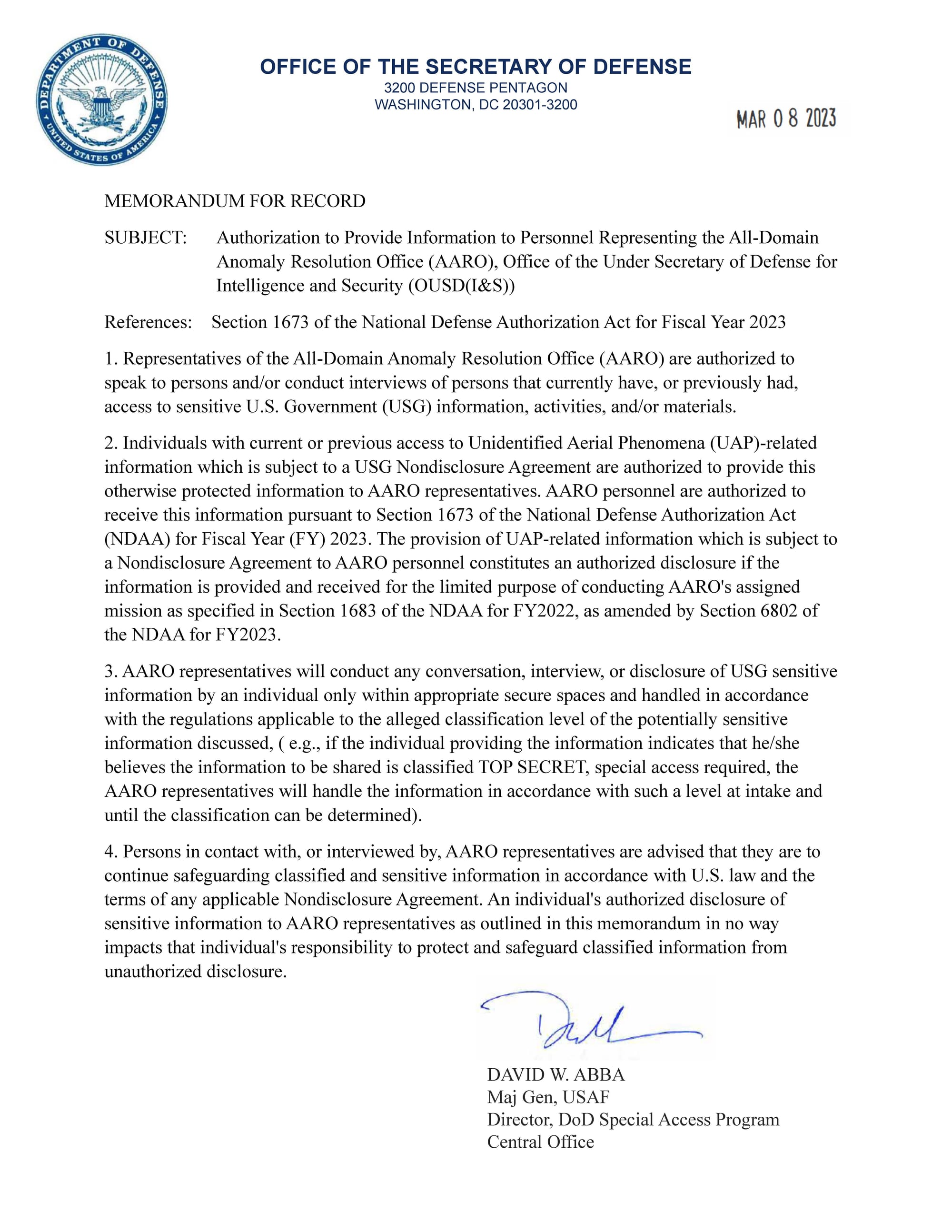
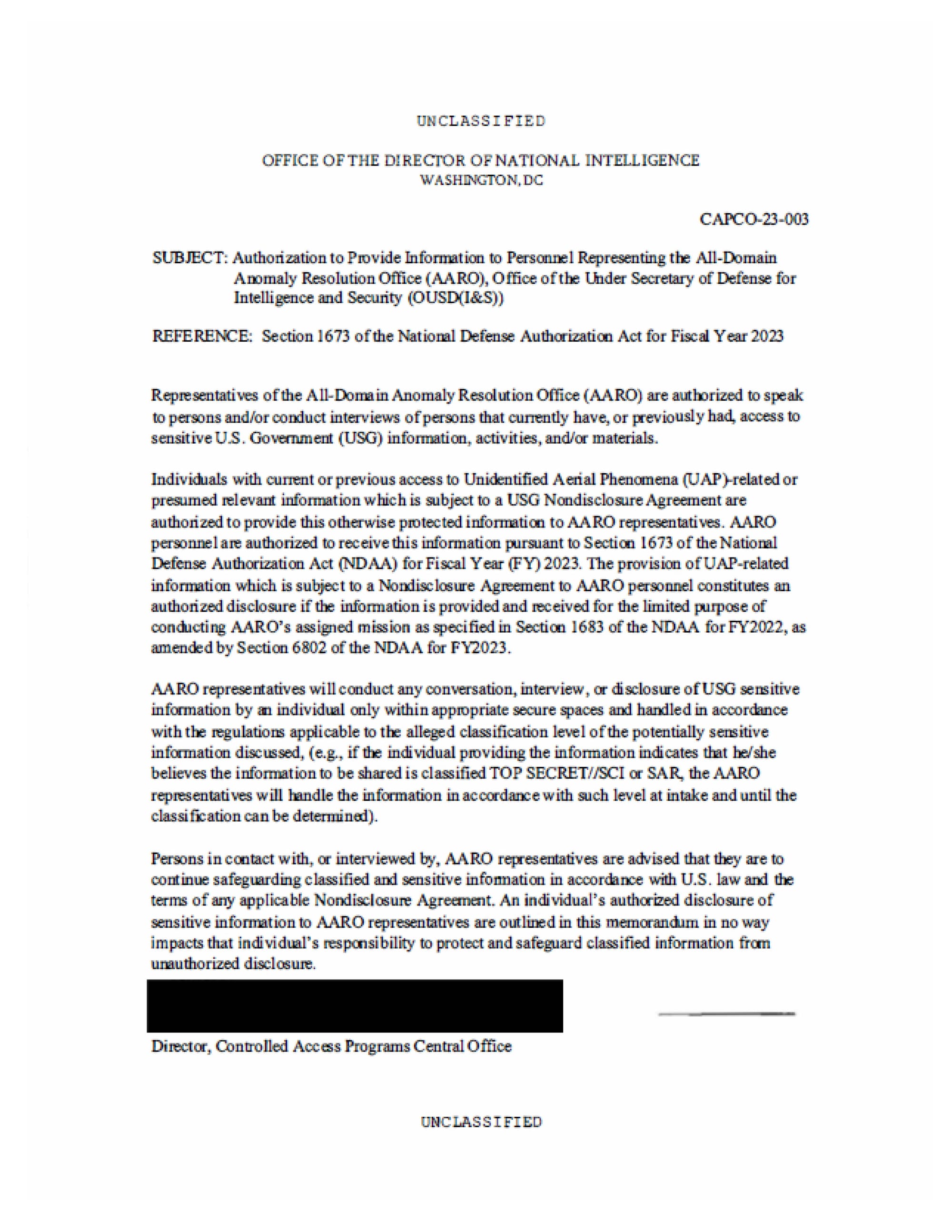
[8] On July 25, 2024, in response to a Freedom of Information Act request, John Greenewald, Jr. of TheBlackVault.com obtained a copy of the implementing directive that the U.S. Marine Corps sent to all of its commands on December 8, 2023, laying out USMC procedures for reporting UAP incidents to AARO. That document is embedded below. In an article reporting on the FOIA release, Mr. Greenewald noted that the Marine Corps directive "mandates an OPREP-3 Special Incident Report (SIR) for any UAP incident, regardless of mission impacts. The OPREP-3 SIR is a report used within the U.S. military to provide immediate notification of any significant incident that could attract national-level interest or affect national security. The OPREP-3 SIR ensures that high-level leadership are promptly informed about incidents that have substantial implications. In the context of UAP reporting, an OPREP-3 SIR is required for any UAP incident, regardless of mission impacts, to ensure timely and accurate reporting and facilitate appropriate responses."
REVISION LOG FOR THIS ARTICLE
(1) September 1, 2024: Added End Note No. 8, noting release by the U.S. Marine Corps to John Greenewald, Jr., of a USMC general administrative directive containing detailed guidance for implementation of the Joint Chiefs directive by USMC commands.